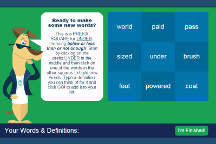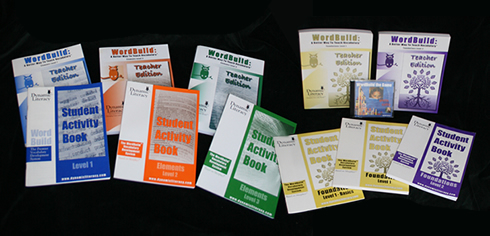The WordBuild® Vocabulary Development System is a vocabulary program that incorporates Dynamic Literacy's trademarked WordBuild® method. In the two Foundations level courses, vocabulary study is based on common words taken from content-area textbooks. Students study compound words, prefixes and suffixes, and they learn spelling and grammar rules for adding suffixes and prefixes. In the three Elements courses students learn the 93 most-commonly used roots from Latin and Greek along with prefixes and suffixes that form those roots into thousands of words.
Each lesson in Foundations begins with an “Affix Square,” a 3-by-3 block of nine squares while Elements lessons begin with a similar "Roots Square." The center square contains the prefix, suffix or root surrounded by words or word elements in the other eight squares. Students begin by creating words from these elements and coming up with their own definitions. Discussion is required to ensure that students have correctly grasped the meanings of words.
In the Foundations books, the second page of each lesson continues with an exercise to combine the featured affix with other word elements, come up with definitions, then write meaningful sentences using each word. The second page of Elements lessons and the third page of Foundations lessons feature a Magic Square puzzle. By properly connecting words and their definitions, students identify which number goes in each square of the Magic Square. Students can self-check because the numbers in the Magic Square should all add up to the same sum when added horizontally or vertically. Foundations lessons continue with a word search activity to create words around the selected affix, using new words derived from the week's affix. Lessons conclude with a fill-in-the-blank activity. Elements books continue on the third day with a stair-step “puzzle” activity. Day four in Elements has two options: a fill-in-the-blanks comprehension activity and/or completing a “word wall” form by listing words along with synonyms and antonyms plus prefixes, suffixes, and roots used in these words. The latter activity should be completed interactively while the comprehension page can be done independently at this level. You can use either or both. Elements lessons conclude with a multiple-choice assessment.
Foundations 1 and 2 courses are suggested for students in grades 2-4 and 4-5 respectively. Elements 1, 2, and 3 are suggested for grades 5-6, 6-7, and 7-8 respectively. However, Elements might also be used at high school level, so do not adhere strictly to these grade level suggestions. In addition, students should always start in the first book of either Foundations or Elements. That means that students in grades 2-5 should start with Foundations 1 and students in grades 5-8 (or above) should start in Elements 1. Notice that fifth graders could start in either series. Students needing remedial work might start at the lower level even if beyond fifth grade.
The first course in both Foundations and Elements begins with some preparatory lessons that differ from the format described. In Foundations, these lessons introduce the concepts of compound words, prefixes, and suffixes. The activity pages are in the separate, 20-page Foundations Basics workbook. For Elements, the activity pages are in an appendix within the student workbook. (Some Elements preparatory lessons are used later, before the third and fifth units.) You might move through them quickly or even skip them if students already understand the concepts.
Courses were designed for classrooms but will work fine with a single student. Most work is done interactively so children are discussing and experimenting with words rather than just memorizing lesson content. Older students will be able to complete more of the activities on their own, but discussion is an essential component of these courses. Lessons should take no more than about 15 minutes per day to complete.
Teacher editions are essential. They include the complete student books with overprinted answers plus explicit instructions that make these courses easy for inexperienced teachers to use. Comprehensive assessments and answer keys are in the back of each teacher edition. Purchase of a teacher edition also gives you access to additional website content that includes printable worksheets from other levels, “Root Bingo” game, a “Colors” chart with fascinating morphemes and derivations from Greek and Latin roots, a “ Body Parts and Substances” chart that might be helpful for anatomy students, as well as lessons derived from scientific vocabulary.
WordBuildOnLine

WordBuildOnLine takes the same concepts and makes them available through an interactive online format. A key feature is that the online version adapts to a student's ability. Like the print version, there are both Foundations and Elements modules. As with the print books, most students up through about sixth grade should start in Foundations, while older students might begin in Elements.
In Foundations, each week's lesson begins with a short video introducing a prefix or suffix that will be studied that week. It does the teaching for you. (There is also a separate video for parents or teachers with more academic content.) How-to videos show students how to complete the five parts of each lesson. A cartoon-dog guides students through the lessons. Students create words with Affix Squares as in the print version. The second activity has students create a new word using the affix of the week then write their own definition of the word on the computer. They then choose the correct meaning from a multiple-choice list. Day three uses the Magic Square for students to match words and definitions. While the fourth activity in the Foundations print books is a word search activity, the online version has a comprehension activity where students choose the correct word to complete a sentence from a word bank. A multiple-choice quiz completes the lesson.
The Elements version online also has five parts per lesson. The first activity is the Root Square, and the second day is the Magic Square. Day three mirrors the stair-step exercise of the print books. The fourth day varies between two activities. The comprehension activity is similar to that used in Foundations and the print books. However, the alternate activity, "In Other Words," challenges students to read a story with morphological definitions that are underlined. Students then answer a series of questions using words from a word bank. This activity helps students understand meanings of words used in context. (If students struggle with "In Other Words," the program will present them with the easier reading comprehension activity more frequently so that they can work at a level that is less frustrating.) Each week concludes with a ten-minute multiple-choice quiz that is timed for only ten minutes.
Students should spend no more than 15 minutes a day on a lesson, and a count-down timer monitors this. Students should not have difficulty completing lessons in that amount of time if they are diligent, but the program adapts if a student is struggling to complete lessons.
On-screen reference tools are available. Students can review any part of a lesson as needed. Progress updates are emailed to a parent or teacher each day. Student progress can also be viewed online at any time.
WordBuildOnLine allows students to work independently, a feature that many parents will appreciate.
WordBuildOnLine is purchased as individual modules for each student. A student can take as long as they need to complete a module—even more than a year. However, a module cannot be reused by another student.
You might want to check out the premade lesson plans from Homeschool Planet that are available for WordBuild OnLine.
Find lesson plans available for this product at Homeschool Planet. Sign up for a 30-day FREE trial.
Summary
WordBuild lessons are briefer and not as difficult as some other vocabulary courses based on roots. More explanation is included about prefixes and suffixes and how they are joined to roots than I have seen in some other programs, making it easier to understand some of the seemingly strange derivations we find in the English language.
WordBuild Game
To add more fun and a real challenge to vocabulary study, you might want to try WordBuild the Game©, an interactive computer game that runs on either Windows or Mac systems. Students use roots, prefixes and suffixes to create as many words as they are able. They can play against time or work at a leisurely pace. More than 18,000 words are in the game's database. In addition to selecting timed or untimed options, students may select from a variety of musical backgrounds.








